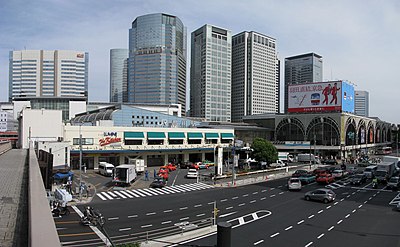
Search
Shinagawa Station

Shinagawa Station (品川駅, Shinagawa-eki) is a major railway station in the Takanawa and Konan districts of Minato, Tokyo, Japan, operated by East Japan Railway Company (JR East), Central Japan Railway Company (JR Central), and the private railway operator Keikyu. The Tokaido Shinkansen and other trains to the Miura Peninsula, Izu Peninsula, and the Tōkai region pass through here. Though a major station in Tokyo, Shinagawa is not served by the Tokyo subway network. However, it is connected to the Toei Asakusa Line via Keikyu through services.
Despite its name, the station is not located in Shinagawa ward. Shinagawa is also commonly used to refer to the business district around the station, which is in Takanawa and Konan neighborhoods of Minato, directly north of Shinagawa ward.
This station is just south of a large yard complex consisting of Shinagawa Carriage Sidings, Shinagawa Locomotive Depot, and Tamachi Depot.
Lines
Shinagawa is served by the following lines:
JR Central
- Tokaido Shinkansen
JR East
- JK Keihin–Tōhoku Line
- JT Tōkaidō Line
- JY Yamanote Line
- JO Yokosuka Line
Keikyu
- KK Keikyu Main Line
JR Central announced in 2011 that Shinagawa will be the terminal for the Chūō Shinkansen, a maglev line under construction and scheduled to begin service to Nagoya in 2027.
Station layout
The main JR station concourse is situated above the platforms running east–west across the breadth of the station. A freely traversable walkway divides the station into two sections. The southerly section contains a number of shops and market-style stalls which form the "e-cute" station complex.
Cross-platform interchange between the Yamanote and Keihin-Tohoku lines is only available for Yamanote Line trains to Shibuya and Keihin-Tōhoku Line trains to Tokyo.
The Keikyu platforms are on the western side of the station at a higher level than the JR platforms. Some Keikyu trains terminate at Shinagawa while others continue on to join the Toei Asakusa Line at Sengakuji.
New ground level Keikyu platforms are currently undergoing construction and are expected to be completed around 2030 as part of the Keikyu's Continuous Grade Separation project.
The Shinkansen platforms were opened on October 1, 2003, to relieve congestion at Tokyo Station. Platforms are on the east side of the station.
JR platforms
- ^note Platform 8 is used for temporary timetables due to construction work or other obstructions elsewhere, or other special services and uses. As an example, in 2021, JR East stabled a Narita Express train at the platform and rented out seats as temporary teleworking spaces.
Shinkansen platforms
Keikyu platforms
History
Shinagawa is one of Japan's oldest stations, opened on 12 June 1872, when the service between Shinagawa and Yokohama provisionally started, four months before the inauguration of "Japan's first railway" between Shimbashi and Yokohama through Shinagawa on 14 October 1872. This line is a part of the Tōkaidō Main Line. Nothing remains of the original structure.
Later on 1 March 1885, the Yamanote Line started operation. Takanawa station of the Keikyu Line (then Keihin Railway Line) opened on 11 March 1924 across the street from Shinagawa station. Takanawa station was renamed Shinagawa station and moved to the current site on 1 April 1933.
The station concourse on the eastern side of the station (located above the platforms) was extensively redeveloped in 2003 in connection with the construction of the Shinkansen platforms and also to improve access to the new commercial development "Shinagawa Intercity".
Keikyu introduced station numbering to its stations on 21 October 2010; Shinagawa was assigned station number KK01.
Station numbering was introduced to the JR East platforms in 2016 with Shinagawa being assigned station numbers JT03 for the Tokaido Line, JO17 for the Yokosuka Line, JK20 for the Keihin-Tohoku Line, and JY25 for the Yamanote Line. At the same time, JR East assigned the station a 3-letter code; Shinagawa was assigned the code "SGW".
Passenger statistics
In fiscal 2017, the JR East station was used by an average of 378,566 passengers daily (boarding passengers only), making it the fifth-busiest station operated by JR East. The passenger figures for previous years are as shown below.
Surrounding area
West side (Takanawa Exit)
- Aqua Park Shinagawa
- National Route 15
- Shinagawa East One Tower
East side (Konan Exit)
- Tokyo University of Marine Science and Technology
Bus services
Services are provided by Toei Bus, Tokyu Bus, Keikyu Bus, Airport Transport Service, and others.
See also
- List of railway stations in Japan
- Transport in Greater Tokyo
References
External links
- Shinagawa Station information (JR East) (in Japanese)
- Shinagawa Station information (JR Central) (in Japanese)
- Shinagawa Station information (Keikyu) (in Japanese)
Text submitted to CC-BY-SA license. Source: Shinagawa Station by Wikipedia (Historical)
Owlapps.net - since 2012 - Les chouettes applications du hibou




